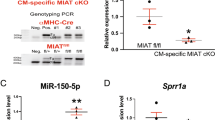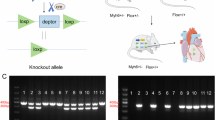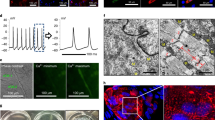Abstract
Myocardial infarction (MI) leads to the loss of cardiomyocytes, left ventricle dilation and cardiac dysfunction, eventually developing into heart failure. Mzb1 (Marginal zone B and B1 cell specific protein 1) is a B-cell-specific and endoplasmic reticulum-localized protein. Mzb1 is an inflammation-associated factor that participates a series of inflammatory processes, including chronic periodontitis and several cancers. In this study we investigated the role of Mzb1 in experimental models of MI. MI was induced in mice by ligation of the left descending anterior coronary artery, and in neonatal mouse ventricular cardiomyocytes (NMVCs) by H2O2 treatment in vitro. We showed that Mzb1 expression was markedly reduced in the border zone of the infarct myocardium of MI mice and in H2O2-treated NMVCs. In H2O2-treated cardiomyocytes, knockdown of Mzb1 decreased mitochondrial membrane potential, impaired mitochondrial function and promoted apoptosis. On contrary, overexpression of Mzb1 improved mitochondrial membrane potential, ATP levels and mitochondrial oxygen consumption rate (OCR), and inhibited apoptosis. Direct injection of lentiviral vector carrying Len-Mzb1 into the myocardial tissue significantly improved cardiac function and alleviated apoptosis in MI mice. We showed that Mzb1 overexpression significantly decreased the levels of Bax/Bcl-2 and cytochrome c and improved mitochondrial function in MI mice via activating the AMPK-PGC1α pathway. In addition, we demonstrated that Mzb1 recruited the macrophages and alleviated inflammation in MI mice. We conclude that Mzb1 is a crucial regulator of cardiomyocytes after MI by improving mitochondrial function and reducing inflammatory signaling pathways, implying a promising therapeutic target in ischemic cardiomyopathy.
Similar content being viewed by others

Log in or create a free account to read this content
Gain free access to this article, as well as selected content from this journal and more on nature.com
or
References
Elgendy IY, Mahtta D, Pepine CJ. Medical therapy for heart failure caused by ischemic heart disease. Circ Res. 2019;124:1520–35.
Maneechote C, Palee S, Chattipakorn SC, Chattipakorn N. Roles of mitochondrial dynamics modulators in cardiac ischaemia/reperfusion injury. J Cell Mol Med. 2017;21:2643–53.
Frankenreiter S, Bednarczyk P, Kniess A, Bork NI, Straubinger J, Koprowski P, et al. cGMP-elevating compounds and ischemic conditioning provide cardioprotection against ischemia and reperfusion injury via cardiomyocyte-specific BK channels. Circulation. 2017;136:2337–55.
Ruparelia N, Chai JT, Fisher EA, Choudhury RP. Inflammatory processes in cardiovascular disease: a route to targeted therapies. Nat Rev Cardiol. 2017;14:133–44.
Rawat P, Teodorof-Diedrich C, Spector SA. Human immunodeficiency virus Type-1 single-stranded RNA activates the NLRP3 inflammasome and impairs autophagic clearance of damaged mitochondria in human microglia. Glia. 2019;67:802–24.
Rosenbaum M, Andreani V, Kapoor T, Herp S, Flach H, Duchniewicz M, et al. MZB1 is a GRP94 cochaperone that enables proper immunoglobulin heavy chain biosynthesis upon ER stress. Genes Dev. 2014;28:1165–78.
Andreani V, Ramamoorthy S, Pandey A, Lupar E, Nutt SL, Lammermann T, et al. Cochaperone Mzb1 is a key effector of Blimp1 in plasma cell differentiation and beta1-integrin function. Proc Natl Acad Sci USA. 2018;115:E9630–9.
Miyagawa-Hayashino A, Yoshifuji H, Kitagori K, Ito S, Oku T, Hirayama Y, et al. Increase of MZB1 in B cells in systemic lupus erythematosus: proteomic analysis of biopsied lymph nodes. Arthritis Res Ther. 2018;20:13.
Zhang Y, Wang Y, Xu J, Tian F, Hu S, Chen Y, et al. Melatonin attenuates myocardial ischemia-reperfusion injury via improving mitochondrial fusion/mitophagy and activating the AMPK-OPA1 signaling pathways. J Pineal Res. 2019;66:e12542.
Yang B, Lin H, Xiao J, Lu Y, Luo X, Li B, et al. The muscle-specific microRNA miR-1 regulates cardiac arrhythmogenic potential by targeting GJA1 and KCNJ2. Nat Med. 2007;13:486–91.
Li C, Li X, Gao X, Zhang R, Zhang Y, Liang H, et al. MicroRNA-328 as a regulator of cardiac hypertrophy. Int J Cardiol. 2014;173:268–76.
Tai Y, Li L, Peng X, Zhu J, Mao X, Qin N, et al. Mitochondrial uncoupler BAM15 inhibits artery constriction and potently activates AMPK in vascular smooth muscle cells. Acta Pharm Sin B. 2018;8:909–18.
Zhou H, Zhu P, Wang J, Zhu H, Ren J, Chen Y. Pathogenesis of cardiac ischemia reperfusion injury is associated with CK2alpha-disturbed mitochondrial homeostasis via suppression of FUNDC1-related mitophagy. Cell Death Differ. 2018;25:1080–93.
Kentner R, Safar P, Behringer W, Wu X, Kagan VE, Tyurina YY, et al. Early antioxidant therapy with Tempol during hemorrhagic shock increases survival in rats. J Trauma. 2002;53:968–77.
Penna C, Perrelli MG, Pagliaro P. Mitochondrial pathways, permeability transition pore, and redox signaling in cardioprotection: therapeutic implications. Antioxid Redox Signal. 2013;18:556–99.
Canto C, Auwerx J. PGC-1alpha, SIRT1 and AMPK, an energy sensing network that controls energy expenditure. Curr Opin Lipido. 2009;20:98–105.
Mills EL, Kelly B, O’Neill LAJ. Mitochondria are the powerhouses of immunity. Nat Immunol. 2017;18:488–98.
Kwon MJ, Shin HY, Cui Y, Kim H, Thi AH, Choi JY, et al. CCL2 Mediates neuron-macrophage interactions to drive proregenerative macrophage activation following preconditioning injury. J Neurosci. 2015;35:15934–47.
Lee PL, Jung SM, Guertin DA. The complex roles of mechanistic target of rapamycin in adipocytes and beyond. Trends Endocrinol Metab. 2017;28:319–39.
Belkaya S, Murray SE, Eitson JL, de la Morena MT, Forman JA, van Oers NS. Transgenic expression of microRNA-185 causes a developmental arrest of T cells by targeting multiple genes including Mzb1. J Biol Chem. 2013;288:30752–62.
Flach H, Rosenbaum M, Duchniewicz M, Kim S, Zhang SL, Cahalan MD, et al. Mzb1 protein regulates calcium homeostasis, antibody secretion, and integrin activation in innate-like B cells. Immunity. 2010;33:723–35.
Groenendyk J, Agellon LB, Michalak M. Coping with endoplasmic reticulum stress in the cardiovascular system. Annu Rev Physiol. 2013;75:49–67.
Xu T, Ding W, Ao X, Chu X, Wan Q, Wang Y, et al. ARC regulates programmed necrosis and myocardial ischemia/reperfusion injury through the inhibition of mPTP opening. Redox Biol. 2019;20:414–26.
Cooper HA, Eguchi S. Inhibition of mitochondrial fission as a novel therapeutic strategy to reduce mortality upon myocardial infarction. Clin Sci (Lond). 2018;132:2163–7.
Thoudam T, Ha CM, Leem J, Chanda D, Park JS, Kim HJ, et al. PDK4 augments ER-mitochondria contact to dampen skeletal muscle insulin signaling during obesity. Diabetes. 2019;68:571–86.
Wu S, Lu Q, Ding Y, Wu Y, Qiu Y, Wang P, et al. Hyperglycemia-driven inhibition of AMP-activated protein kinase alpha2 induces diabetic cardiomyopathy by promoting mitochondria-associated endoplasmic reticulum membranes in vivo. Circulation. 2019;139:1913–36.
Pfanner N, Warscheid B, Wiedemann N. Mitochondrial proteins: from biogenesis to functional networks. Nat Rev Mol Cell Biol. 2019;20:267–84.
Rowland AA, Voeltz GK. Endoplasmic reticulum-mitochondria contacts: function of the junction. Nat Rev Mol Cell Biol. 2012;13:607–25.
Wu S, Lu Q, Wang Q, Ding Y, Ma Z, Mao X, et al. Binding of FUN14 domain containing 1 with inositol 1,4,5-trisphosphate receptor in mitochondria-associated endoplasmic reticulum membranes maintains mitochondrial dynamics and function in hearts in vivo. Circulation. 2017;136:2248–66.
Li Q, Tursun D, Shi C, Heyrulla M, Zhang X, Yang W. Ziziphora clinopodioides flavonoids protect myocardial cell damage from myocardial ischemia-reperfusion injury. Evid Based Complement Altern Med. 2018;2018:8495010.
Yang J, He J, Ismail M, Tweeten S, Zeng F, Gao L, et al. HDAC inhibition induces autophagy and mitochondrial biogenesis to maintain mitochondrial homeostasis during cardiac ischemia/reperfusion injury. J Mol Cell Cardiol. 2019;130:36–48.
Butterick TA, Hocum Stone L, Duffy C, Holley C, Cabrera JA, Crampton M, et al. Pioglitazone increases PGC1-alpha signaling within chronically ischemic myocardium. Basic Res Cardiol. 2016;111:37. https://doi.org/10.1007/s00395-016-0555-4.
Kou G, Li Z, Wu C, Liu Y, Hu Y, Guo L, et al. Citrus tangeretin improves skeletal muscle mitochondrial biogenesis via activating the AMPK-PGC1-alpha pathway in vitro and in vivo: a possible mechanism for its beneficial effect on physical performance. J Agric Food Chem. 2018;66:11917–25.
Acknowledgements
This study was supported by the National Natural Science Foundation of China (81770284, 31671187, 81673425), and the CAMS Innovation Fund for Medical Sciences (CIFMS, 2019-I2M-5-078).
Author information
Authors and Affiliations
Contributions
HHL and BFY designed and supervised all aspects of the study and analysis. LZ, YNW, JMJ, AS, YL, and TYL performed study and analysis the data. RNF, JBS, YYG, TZJ, and YYL assisted in this study. HLS, HHL, and BFY finalized the manuscript.
Corresponding authors
Ethics declarations
Competing interests
The authors declare no competing interests.
Rights and permissions
About this article
Cite this article
Zhang, L., Wang, Yn., Ju, Jm. et al. Mzb1 protects against myocardial infarction injury in mice via modulating mitochondrial function and alleviating inflammation. Acta Pharmacol Sin 42, 691–700 (2021). https://doi.org/10.1038/s41401-020-0489-0
Received:
Accepted:
Published:
Issue date:
DOI: https://doi.org/10.1038/s41401-020-0489-0
Keywords
This article is cited by
-
Identification of core genes related to exosomes and screening of potential targets in periodontitis using transcriptome profiling at the single-cell level
BMC Oral Health (2025)
-
Study on the mechanism of OSM participating in myocardial fibrosis by inhibiting TGFβ-induced EndMT of cardiac microvascular endothelial cells through SPARC/SMAD signaling
Naunyn-Schmiedeberg's Archives of Pharmacology (2025)
-
MZB1-Driven Endoplasmic reticulum stress model as a predictor of breast cancer progression and survival
Functional & Integrative Genomics (2025)
-
B-cell hub genes play a cardiovascular pathogenic role of in childhood obesity and Kawasaki disease as revealed by transcriptomics-based analyses
Scientific Reports (2024)
-
Mzb1 Attenuates Atherosclerotic Plaque Vulnerability in ApoE-/- Mice by Alleviating Apoptosis and Modulating Mitochondrial Function
Journal of Cardiovascular Translational Research (2024)


